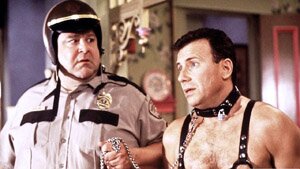
While I didn’t (and still don’t) think much of the movie One Night at McCool’s, I found the review I did of it a decade or so ago intriguing because of what I wrote about how stories work. I don’t think I’m quite as dogmatic about it today as I was then, but generally I still agree with what I wrote.
Audiences have certain expectations and when they are not met, you either have to have a very good, well thought out reason for not meeting them or else suffer the consequences of people finding nothing worth a damn in your film.
(That is a way of saying you will have made a bad movie. Another example of this is 2002’s People I Know.)
Stories have arcs. Here’s how Wikipedia puts it: “The purpose of a story arc is to move a character or a situation from one state to another; in other words, to effect change.”
If you have no arc – read “change” – you have no story. And no one wants to see that:
One Night at McCool’s (2001)
I hate to be prissy about it, but I think there are certain things you do and don’t do in stories. And I think you often find artists struggling with this. There is a tension between what artists want to say in order to reveal truth in their work, and what structure and genre demand … (Read more)



